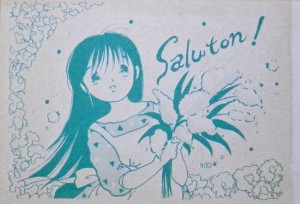I have mixed feelings about my CIP experience.
First, the good: there is no doubt that the CIP can provide experiences that a ryuugakusei might not otherwise have access to in Japan. Although interacting with our host families and with the outgoing KIXS and DESA members is certainly good language practice and often a lot of fun, generally the families that choose to host and the students that choose to join international circles are used to interacting with foreign students and enthusiastic about it. Thus, chances are we’ll be spoken to in language we’re more likely to understand; our mistakes will be more readily forgiven/breezily ignored; each participant in the interaction has a better idea of what to expect from the other. In other words, it’s less of a challenge. However, when one reaches out to a circle or community organization, one may encounter people who have never met a ryuugakusei before, creating more pressure on both ends. Talking to the people at Kyodai Orchestra was a huge change from hanging out with my host family or my KIXS/DESA friends–from their slang/vocabulary (I was totally thrown by “ikkaisei” and “gakubu” in lieu of “ichinensei” and “senmon” at first) to their mannerisms. Suddenly being polite and following cultural expectations became a lot more important–which, if I’m not mistaken, is part of the intended value of the CIP. It keeps us from getting complacent, which is definitely beneficial.
However, I must unfortunately voice disagreement with some of the things we were told at the CIP information session at the beginning of the year: namely, that it’s best to pick an activity you are very familiar with and/or good at. I understand the motivation behind that, but I honestly wish I had tried to learn (for example) the koto from scratch, or done something I was perhaps vaguely familiar with, rather than try to play cello in an orchestra, something I have done in the States for about ten years. Because I’ve been heavily involved in the Western classical music world for so long, a world in which the structure and expectations are very familiar to and beloved by me, the cultural differences in the Kyodai Orchestra system grated on and sometimes even upset me, rather than opening my mind to learning opportunities. Considering that I’ve largely found it easy to embrace cultural differences in general since coming to Japan, that is a significant thing to say. Therefore, I would recommend for future students: choose a CIP you are interested in, to be sure, but perhaps avoid an activity which you feel strongly about or are very used to in its Western form. In terms of Kyodai Orchestra specifically, the people are kind and welcoming, but due to the lack of an audition process, it’s impossible to enter the main orchestra, so that would be another thing to keep in mind.
Additionally, I feel that were I studying abroad for a full year, I would have been more motivated to form meaningful connections with the other orchestra members. For the first month and a half that I attended my CIP, I was only doing individual practice in the strings building, because they weren’t sure in what capacity I could enter the orchestra yet. I didn’t consistently see the same people every week, and it wasn’t until after I’d joined the first-year orchestra (as I mentioned above, joining the main orchestra wasn’t an option), which in turn wasn’t until mid-November, that I received a welcome party and actually had an extended interaction with the people I was playing with. Because I will probably only see them once or maybe twice more and then return to the States, I feel that I quickly dismissed the possibility of lasting friendship, which is a shame. Nevertheless, I enjoyed the welcome party much more than I expected to, and it provided me with an opportunity to experiment with some of the wakamono no kotoba and Kansai-ben I’ve picked up since I’ve come to Japan–since the other orchestra members aren’t particularly familiar with the formalized college-Japanese-student language I arrived here speaking, I wasn’t looked askance at, which was quite gratifying (though I don’t mind being mocked in a friendly way by others, of course.)
To conclude, there’s definitely no way I can say my CIP was worthless, but I feel I could have gotten more out of it than I did, which is both my own fault and that of external factors that couldn’t really be controlled.

